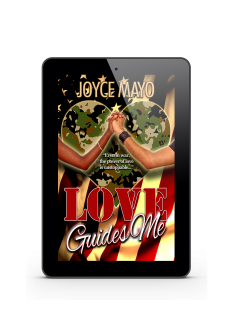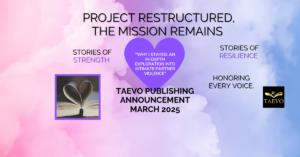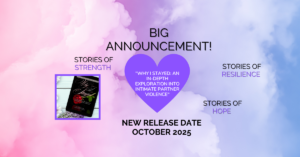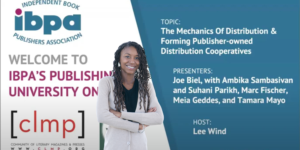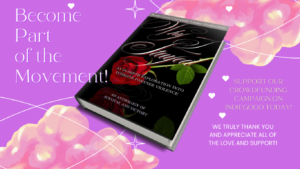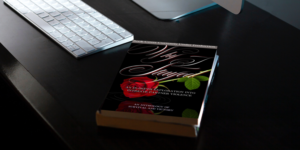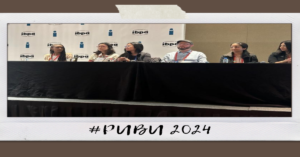Many of the questions that new authors ask pertain to publishing their book the right way. There is a plethora of misinformation and conflicting data out there, and it’s because people are straight-up lying to you and exploiting what you don’t know in order to get your money. As a result, authors are still running around in circles trying to figure out the proper steps, and they can’t always afford one-on-one help.
So much incredibly bad information exists out there, some days we don’t know where to start when it comes to sorting it all out and setting people back on the right path. Someone actually commented once, “I know you can self-publish your book for like, $30 or $40”, and I was speechless for a moment. Mainly because they said it with such confidence and so matter-of-factly. Despite being shown proof that it was not true, they believed it to be a truth – even though it has been proven false time and time again.
This type of misinformation is part of what Taevo continues to battle, and it’s a fight expected to continue the fight well into the new year and beyond. Many small independent traditional publishers are attempting to correct all of the half-truths that exist in publishing. Meanwhile, people who have no real knowledge of publishing – beyond what they found on a Google search and read on blogs – pass along information that is not only grossly false, but dangerous to the novice who could potentially lose thousands of dollars in said “guru’s” course as a result.
Here’s the blunt truth: If you want to succeed in the publishing world, you have to understand it. It’s not just one part of this world that you must break down – there are several. You need to know the process your manuscript goes through to become a finished book, while also learning the process of how publishers get those books into stores globally. You need to understand the business of publishing, not just the glamour of saying you’re a published author.
Here are some absolutely great reads that will answer your questions on how to publish your book properly and professionally, even if you’re self-publishing. These are usually the first ones suggested to new authors and those seeking valid expert knowledge beyond a Google search. These books are written by people who have actually done it and are not afraid to tell you the ugly, adulterated truth about the publishing world.
Like many authors, the books they wrote had a narrow, niche topic that traditional publishing houses typically shy away from. The big boys like to market and promote on a grand scale, and they invest in books that offer wider mainstream crossover success. Books geared toward one particular market – like white water rafting, for example – make them nervous.
Rather than sit in obscurity, these authors took the initiative to learn the phases a book goes through to become a finished product, as well as the business of publishing and marketing on a wider scale.
Before you dive into the publishing world, be sure to arm yourself with sound, reputable information from those who have shown what the steps are to win, and what you need to do to be part of the winning team.
If you are looking for something to help you get started on a successful publishing path, then here are the four books it’s recommended you start out with.
How To Self-Publish & Market Your Own Book, 3rd Edition by Mack E. Smith and Sara Freeman Smith
Written and published by an African-American husband and wife team, this book is actually one of the premier reference guides for minorities looking to publish. They have successfully navigated the wilds of the publishing world, gained success by learning from other experts, and tweaked the process to suit them (as every self-published author should do). This book tentatively addresses the issues that minorities and women face with regards to getting published, as this is still a white male dominated industry. It takes courage to talk about the elephant in the room, and they do it with class.
Notable chapter read: “Chapter 10: Tips and Resources for Women and Minorities”
This special chapter was added for the 3rd edition. Focusing on minority and women writers, the authors speak about the different challenges we may encounter on our publishing journey and offers practical solutions to common problems. This chapter also includes an extensive list of venders, book reviewers, organizations, websites, and other helpful resources that further help minorities promote their book and connect with their audience.
The Self-Publishing Manual: How to Write, Print, and Sell Your Own Book – 16th Edition by Dan Poynter
Here’s what I figured out from his book and why I like this author so much: he took the time to learn how the larger publishing houses produced books, then did it on a smaller scale to suit his budget and needs. He understands that this is a business, and if you’re going to jump in and self-publish, be ready to do business in a knowledgeable, professional, no-nonsense manner… or be eaten alive by the ones who do. He’s not a writer, so don’t expect the highest level of prose in the world, but he’s one heck of a marketer, and this book will provide you with certain fundamentals you need.
Notable chapter reads: “Chapter 4: Producing Your Book”
If I can stress anything with regard to learning the essential aspects of book production, this is the chapter to read. Poynter walks you through the phases your manuscript will go through before it actually emerges as a bound, printed book – and learn what key terms like running heads, folios, and signature mean. Acquiring this kind of knowledge sheds light on which tasks you can do on your own, as opposed to which ones you should contract out.
This is literally the starting point for your journey. This book takes you from the beginning to the end – the writing and conception of your manuscript to the printed book and marketing/promotion.
The Well-Fed Self-Publisher by Peter Bowerman
I like books that are practical, down-to-earth, and break complicated things down using a logical, real-world manner, and this book does all of that and more. Plus, he’s actually pretty funny. I found myself chuckling quite a few times as I read through it. His writing tone is friendly and conversational, but what I like most is his in-your-face honesty. The guy is blunt to a “T” and doesn’t sugar coat the realities of the publishing world, especially for those of you seeking a traditional publishing deal.
He backs up his information with in-depth research, interviews with other authors, and valuable insight from vendors like book printers and cover designers. He gives examples of press releases, buzz-inducing articles you can write, and a whole plethora of ways you can promote your book for free or at a lower cost.
Notable chapter reads: “Chapter 4: Bullseye! Targeting Buyers and Building Demand”; “Chapter 9: Free Publicity – the ‘Write’ Way”
I like and suggest this book because of its heavy focus on how to uniquely market your book. He addresses the fears we all have of selling, and offers sound strategies on how to steadily build your fan base over time. This is only a taste of the valuable information that will change the way you feel about marketing your book. One of the tips I got from him is the reason Taevo Publishing was born: you’ll earn more credibility as a self-published author with a publishing company behind you. He started Fanove, I started Taevo… and many other self-publishers have done the same thing. The only difference is, I now have authors signed to my company.
I just love that Bowerman makes all of this fun. The way he presents the material to you gets you fired up and ready to start selling now.
How To Start & Run A Small Book Publishing Company – Peter I. Hupalo
It’s only 160 pages long, but a great read about running a small publishing company. Yes, some of the topics are seemingly boring, like sales tax issues, accounting, business structure, and things that involve math concepts – like calculating your book’s worth and transforming it into future revenue. However, those skills are required when you self-publish your book.
Notable chapter reads: Chapter 4: Book Pricing and Book Industry Terms-How Not To Lose Your Shirt!
There is much about publishing that will potentially overwhelm you, making you want to run the other way. Things like, “How am I going to distribute my books? Can I really handle consignment deals on my own?” Do you even know what “consignment” is? Are you trying to spread your message on that level?
The reason so many authors lose money and become disenchanted with the publishing world is because they don’t approach the business aspect of it properly. We’re so enamored with the dream of being published that we fail to use sound business logic for the most routine duties, such as calculating how much profit you need to generate in order to print more books. It seems dry, but it’s what will keep more money in your pocket, while bringing in higher profits from book sales.
The only complaint with this book is that it screamed ‘self-published book’ and the cover was kind of cheap-looking. It embodies everything authors are warned not to do with regard to self-publishing, and what your book should NOT look like after you’ve paid money. But with the solid gold content inside, it’s an A++.
Closing Out With A Few More Suggested Titles
Keep in mind, we’ve read dozens of books about publishing, writing, and running a small publishing house. There are so many more great books out there. Conflicting information definitely exists out there based on people’s individual experiences; however, there are certain fundamentals in publishing that must be learned, and each of these books contains them.
It’s understood that not everyone wants to read books. Some people learn differently, whether it’s via YouTube, audiobooks, PowerPoint, webinars, blogs, etc. The information offered in the books I’m suggesting is also available through their websites as bonus material, kits, seminars, and even one-on-one consultations.
Please go deeper than a Google search of “How do I publish my book?”, watching a couple of YouTube videos, or reading a few blog articles to learn more about the publishing process. Seek advice from several experts and implement the practices you notice keep getting repeated throughout each book. If you don’t want to seek the advice of an expert, or simply feel you can’t afford to, then keep in mind that there are many helpful books out there.
It’s our obligation to share where you can obtain good, solid information that will begin to fill in the gaps pertaining to the how’s and why’s of publishing. Before you embark on the publishing path, you need to conduct research that will shed light on the confusing and contradictory world of publishing.
We will be suggesting more books for you after the new year comes in, and additional information will be available regularly. There are a lot of jewels out there, and you’ll want to be in the know. A couple of examples are: The Complete Guide to Self-Publishing by Tom and Marilyn Ross and How To Publish, Promote, and Sell Your Own Book by Robert Lawrence Holt.
Feel free to chime in and share some of your favorites as well. What books have you read that really helped you learn and navigate the publishing world? Which ones didn’t you like and why?
Sound off and share your thoughts by leaving a comment!

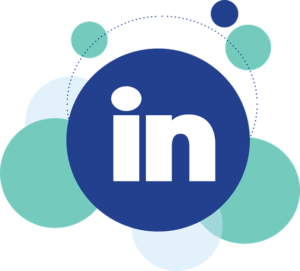
![Too Late To Turn Back [EBOOK]](https://www.taevopublishing.com/wp-content/uploads/2020/11/2-1-250x333.png)
